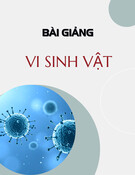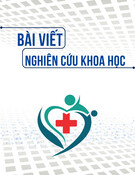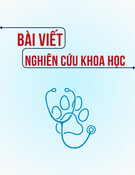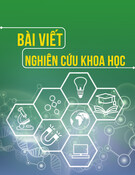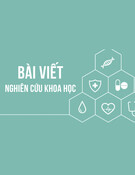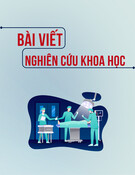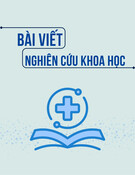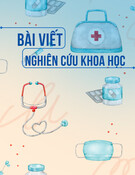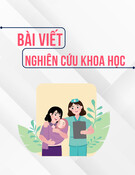
JOURNAL OF MILITARY PHARMACO-MEDICINE N04 - 2025
145
THE EFFECTIVENESS OF LASER ACUPUNCTURE COMBINED WITH
ACUPRESSURE MASSAGE IN PATIENTS SUFFERING
FROM LOW BACK PAIN DUE TO SPONDYLOSIS
Nguyen Thanh Ha Tuan1*, Nguyen Thi Viet Chinh1
Abstract
Objectives: To evaluate the effectiveness of laser acupuncture (LA) combined
with acupressure massage in treating low back pain, focusing on pain intensity,
functional disability, and lumbar range of motion. Methods: An uncontrolled,
randomized, clinical trial was conducted to compare the effectiveness before and
after treatment in 30 volunteered patients aged ≥ 38 diagnosed with low back pain
due to spondylosis, regardless of gender or occupation, at the Traditional Medicine
Department, Military Hospital 103. Results: Combining the LA method with
acupressure massage showed good effectiveness, with a success rate of 96.7%. The
pain level, according to the Visual Analogue Scale (VAS), improved significantly
after 14 days of treatment, decreasing from an average of 5.4 ± 1.886 to 1.17 ±
1.234 (p < 0.05). The lumbar spine expansion and daily activity limitation
measured by the Oswestry Disability Index (ODI) significantly improved.
Conclusion: The treating method using LA combined with acupressure massage
has been proven to be an efficient adjunct therapy in treating low back pain due to
spondylosis.
Keywords: Laser acupuncture; Acupressure massage; Low back pain;
Spondylosis; Lumbar spine degeneration.
INTRODUCTION
Low back pain is a pain syndrome
characterized by the compression or
irritation of nerve roots in the lumbar
region of the spine, with an average
prevalence in the general population
ranging from 5 - 10%. According to
Christopher E Alexander (2025), this
syndrome is the leading cause of
disability among individuals aged 45
and older in developed countries [1].
1Military Hospital 103, Vietnam Military Medical University
*Corresponding author: Nguyen Thanh Ha Tuan (nguyentuan000010@gmail.com)
Date received: 25/02/2025
Date accepted: 26/3/2025
http://doi.org/10.56535/jmpm.v50i4.1234

JOURNAL OF MILITARY PHARMACO-MEDICINE N04 - 2025
146
The symptoms include lower back pain
that radiates down the lower extremities
along the compressed nerve roots,
accompanied by numbness and burning
sensations along the sciatic nerve
pathway [2].
From a traditional medicine perspective,
low back pain due to spondylosis is
described within the scope of “Bi
syndrome” with the disease name “Yao
Tong”. Treatment in traditional medicine
includes both pharmacological and non-
pharmacological methods such as
acupuncture, electroacupuncture, hydro-
acupuncture, acupressure massage,
moxibustion, and qigong. In recent
years, the integration of traditional and
modern medicine has garnered increasing
attention, with more combined techniques
being applied, including LA. LA is
becoming a reliable treatment method
by leveraging the biological stimulation
effects of laser light combined with
acupuncture point theory according to
traditional medical theory, which
unblocks meridians, harmonizes Qi,
and relieves pain. However, there is still
insufficient evidence to evaluate the
efficacy of this method, so we conducted
the research to: Assess the effectiveness
of the laser method combined with
acupressure massage to treat low back
pain due to spondylosis.
MATERIALS AND METHODS
1. Subjects
Including 30 patients aged ≥ 38 years,
regardless of gender or occupation,
diagnosed with low back pain due to
spondylosis came for examination and
treatment at the Traditional Medicine
Department, Military Hospital 103. In
traditional medicine, patients were
diagnosed with “Yao Tong” due to liver
and kidney Ying deficiency. Patients
voluntarily participated and complied
with the treatment regimen and did not
apply other treatments during the
period, which comprised data related to
the 6-month period from June 2024 to
December 2024.
* Exclusion criteria: Patients with a
history of allergies; pregnant women;
spinal tuberculosis; cancer; surgical
indications or severe chronic diseases
(liver, kidney, heart failure, severe
hypertension, diabetes, etc.).
* Criteria for treatment discontinuation:
Patients who refused to continue; did
not adhere to treatment, or experienced
side effects (increased pain, skin redness,
itching, burning, etc.).
* Research materials: Laserneedle
touch (manufactured and developed by
the Laserneedle GmbH Company of the
Federal Republic of Germany, consisting
of 10 laser emitters, including 7 red
light emitters with a wavelength of
658nm and 3 blue light emitters with a

JOURNAL OF MILITARY PHARMACO-MEDICINE N04 - 2025
147
wavelength of 405nm); measuring tape;
VAS; ODI questionnaire.
2. Methods
* Research design: An uncontrolled,
randomized, clinical trial comparing
effectiveness before and after the
treatment.
* Research sample size: 30 patients.
* Procedure:
- Clinical examination and imaging
(X-ray of the lumbar spine).
- Patient selection.
- Treatment protocol:
+ LA: 1 time a day, continuous for
15 minutes in 14 days (except Saturday
and Sunday). Using eye protection
glasses for both patients and medical
staff. Acupuncture formula: Ashi point,
Jiaji L4-L5, Jiaji L5-S1, Weizhong
(bilateral). Using 7 red light emitters
with a wavelength of 658nm at a
frequency of 935.5Hz and a power
density of 4.07 W/cm2 for 15 minutes.
+ Acupressure massage: According
to the Traditional Medicine Technical
Process of The Ministry of Health in
2013, these movements include rubbing,
squeezing, rolling, pressing, acupressure,
distribution, and lumbar spine exercise.
1 time a day for 15 consecutive minutes
in 14 days (except Saturday and Sunday).
- The indicators are monitored and
evaluated before treatment and at D7
and D14.
- Observing any side effects.
* Research criteria:
General characteristics of the research
subjects include age, gender, occupation,
and duration of pain.
Clinical criteria: Conducting evaluation
at the time D0, D7, and D14.
- Evaluating the level of pain according
to the VAS. The VAS score from 1 - 10
according to the level of pain: The
patient was selected with 3 ≤ VAS ≤ 8.
- Measurement of lumbar spine
expansion (Schober’s test) is classified
into 4 levels: Good, fair, moderate, and
poor. Normally, the daily index ranges
from 14 - 16cm, a measurement of less
than 14cm is considered abnormal.
- Assessment of daily activity limitation
using the ODI questionnaire: This
consists of 10 questions evaluating the
extent of daily activity limitation in
patients diagnosed with low back pain.
The assessment focuses on 8 out of 10
activities: Pain intensity, self-care, lifting,
walking, sitting, standing, sleeping, and
social activities. Each activity is scored
from 0 - 5, with a total score ranging
from 0 - 40. A higher score indicates
greater impairment in daily functioning.
The functional limitation index is calculated
based on the Oswestry Disability:
ODI% = (Actual score / Theoretical
score) * 100%
- Clinical symptoms in traditional
medicine: Irritability, hot flashes, wiry
pulse, red tongue, and yellow coating.

JOURNAL OF MILITARY PHARMACO-MEDICINE N04 - 2025
148
- The overall effectiveness of
the treatment was based on the
comparison of the total scores (VAS,
Schober index, and ODI) before and
after treatment.
* Statistical analysis:
The data analysis in this study was
conducted using SPSS version 27.0.
The results are shown in the form of
average value ± standard deviation and
percentage. The Nonparametric Wilcoxon
matched-pairs signed-rank Test and
Friedman Test were used at each time
point compared to D0. The research
results are considered statistically
significant when p < 0.05.
3. Ethics
The research complied with all
regulations and has been approved for
use and publication according to the
instructions of the Traditional Medicine
Department, Military Hospital 103.
Patient personal information is used
exclusively for research purposes. The
authors declare to have no conflicts of
interest in the research.
RESULTS
1. General characteristics of the research subjects
Table 1. General characteristics of the research subjects.
Criteria
Frequency (n)
Percentage (%)
Sex
Female
17
39.4
Male
13
51.5
Age (year)
< 40
4
13.3
40 - 59
18
66.7
≥ 60
6
20
Average age
(year, X
± SD
)
60.37 ± 11.19
Duration of pain
(month)
≤ 3
5
16.7
3 - 6
7
23.3
≥ 6
18
60
Occupation
Manual labor
19
63.3
Intellectual labor
11
36.7

JOURNAL OF MILITARY PHARMACO-MEDICINE N04 - 2025
149
The study included 30 patients, consisting of 17 females and 13 males. The
average age was 60.37 ± 11.19, ranging from 36 - 75 years old. The highest disease
prevalence was observed in the 40 - 59 age group, accounting for 66.7%. The
majority of affected individuals were manual laborers. 60% of patients had been
suffering from the disease for more than 6 months.
2. Evaluation of treatment effectiveness
Table 2. Classification of pain intensity.
Day
Pain levels (%)
p
Severe pain
Moderate pain
Mild pain
No pain
D0
36.7
43.3
20
0
D7
0
33.3
53.4
13.3
< 0.001
D14
0
3.3
46.7
50
< 0.001
The changes in pain intensity occurred early at D7 compared to D0 (p < 0.05).
After 14 days of treatment, the pain intensity decreased markedly, with a
statistically significant difference (p < 0.05).
Table 3. Changes in average VAS, Schober index, and ODI %
before and after treatment.
Scale
D0
(
± SD)
D7
(
± SD)
D14
(
± SD)
p
VA S
5.4 ± 1.886
2.8 ± 1.919
1.17 ± 1.234
< 0.001
Schober index
(cm)
13.15 ± 0.464
13.75 ± 0.548
14.38 ± 0.741
< 0.001
ODI (%)
66.4 ± 18.226
42.75 ± 19.79
26.75 ± 11.27
< 0.001
The average VAS score and ODI % showed a decreasing trend over the follow-
up period, whereas the average Schober index gradually rose. The differences
between the pre-treatment time point (D0) and the post-treatment time points
(D7, D14) were statistically significant (p < 0.05).

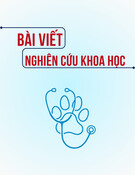
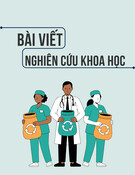
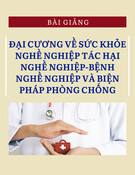







![Tài liệu Triệu chứng học nội khoa [mới nhất]](https://cdn.tailieu.vn/images/document/thumbnail/2025/20251204/oanhlahet@gmail.com/135x160/5231764900514.jpg)


![Bài giảng Vi sinh vật: Đại cương về miễn dịch và ứng dụng [chuẩn nhất]](https://cdn.tailieu.vn/images/document/thumbnail/2025/20251124/royalnguyen223@gmail.com/135x160/49791764038504.jpg)
